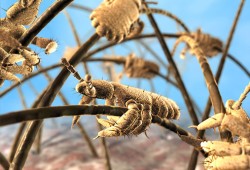
Types of LiceInfestation in the Body
Several types of lice may exist in the body. They live on the surface of their hosts and need these hosts to be able to reproduce.Lice are usually classified by their location in the body:
- Head lice (Pediculushumanuscapitis)
- Most common
- Develop in the scalp
- Easiest seen at the nape of the neck and over the ears
- Body lice(Pediculushumanuscorporis)
- Slightly larger than head louse
- Thrive in clothing and bedding
- Move on to the skin to feed
- Usually occur in individuals who do not bathe regularly or change clothing everyday
- Pubic lice(Pthirs pubis)
- Commonly called crabs
- Found in the skin and hair of the pubic area
- Rarely, they occur on coarse body hair, such as eyebrows, eyelashes and chest hair
Causes of Lice Infestation
As highly contagious insects, there are various ways of acquiring lice infestation in the body
- Head lice
- Sharing hairbrushes, combs, pillows, headphoneshats
- Nothing to do with personal hygiene
- Usually asymptomatic
- Body lice
- Poor hygiene
- Irregular changing of clothes, beddings, etc.
- Associated with poverty and overcrowding
- Pubic lice
- For adults, intimate and/ or sexual contact with someone who has crabs
- For children, nonsexual transmission from parents
Symptoms of Lice Infestation
If one thinks that they have a possible life infestation anywhere in the body and cannot directly see them, it may be better to ask someone to examine. An adult-sized louse is the same size of sesame seed or slightly larger. However, the common symptoms of lice infestation include:
- Intense itching
- Tickling feeling from movement in the hair or body
- Small, red bumps on the scalp, neck and shoulders
- Presence of lice eggs (nits), which look like small pussy willow buds and cannot be brushed off the hair easily
Treatment of Lice Infestation
Although lice may have already been killed and washed away, itching may persist due to an allergic reaction from their bites. There are different ways to treat the three types of lice infestation in the body. The steps to be mentioned below do not substitute for medical advice or professional first aid training.
- Head lice
- It is easier to look for lice when the hair is wet
- Use a fine-toothed comb, magnifying glass, clear tape and strong light to search for lice. This should be done every two to three days over a two-week period.
- If lice are found, use anti-lice shampoo. Follow the directions given my manufacturer.
- Use this twice and again after a week to ten days to kill newly hatched nits.
- If lice are still present after two applications, seek a doctor and anti-lice prescription may be given.
- Check all household members for louse.
- Wash al bed linens and clothing that came in contact with infected person. Use warm water. Vacuum floors and furniture.
- Disinfect combs and brushes in hot water.
- Body lice
- Thoroughly wash the body with soap and water.
- Check all household members for louse.
- Wash al bed linens and clothing that came in contact with infected person. Use warm water. Vacuum floors and furniture.
- If there is itching, use over-the-counter antihistamines.
- Pubic lice
- Treat twice using anti-lice agents and again after a week.
- Remove nits.
- Wash al bed linens and clothing that came in contact with infected person. Use warm water. Vacuum floors and furniture.
If lice infestation or nits are present in coarse body hair, apply petroleum jelly two times a day for eight days.
